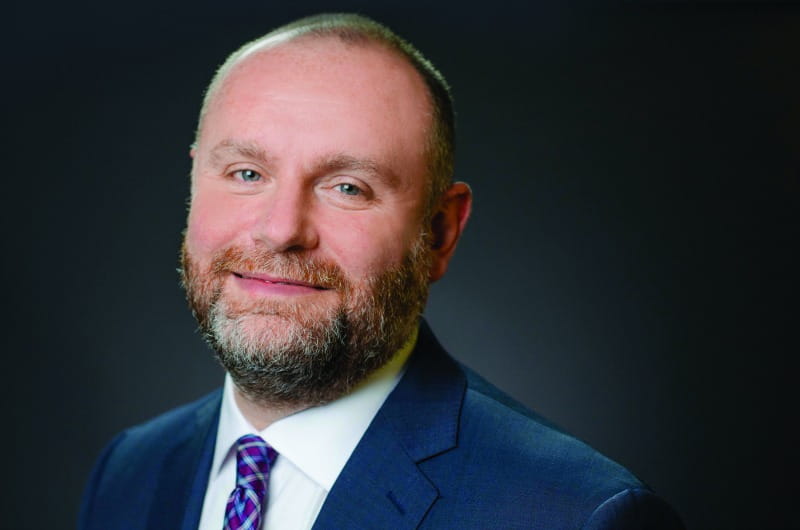Q&A With Senior Vice Provost for Research Aleister Saunders
 By Adam Stone
By Adam Stone

As a professor of biology, Aleister Saunders leads an active research group investigating the molecular and cellular underpinnings of Alzheimer’s disease. His work is helping to point the way toward novel therapeutic strategies to delay or prevent the onset of dementia. But that’s not the only hat he wears.
As senior vice provost for research, he plays a very different role as he works to build and sustain momentum across Drexel’s vast research enterprise.
Saunders’ plan took a huge step forward this spring, when the U.S. Department of Defense tapped Drexel to be a lead player in the creation of a $75 million national research institute that will support American textile manufacturers in bringing sophisticated new materials and textiles to the marketplace. Saunders calls the Advanced Functional Fabrics of America (AFFOA) project a highly visible example of how an interdisciplinary approach can benefit research all across the university.
Q: Why was AFFOA such a significant milestone for Drexel research?
A: First, because we competed at a national level against some of the top universities in the country and we won. It is that, as well as the fact that this is a really unique area of research. There aren’t many places that have research on functional fabrics.
Most importantly, we believe we are at the beginning of a brand-new industry that is going to shape all of our lives. We really think this puts us in on the ground floor of something that is going to impact the way we live as individuals and as a society. And for the university, it’s not just the research. Our students will have an opportunity access training that will give them a unique advantage in their careers.
Q: What made the AFFOA effort successful? Lessons learned?
A: Ultimately it was about nimbleness, agility. We weren’t tied to any dogma. We were only tied to finding new ideas of the way things should be. We just wanted to find the best way to establish this industry. That openness allowed us to come up with out-of-the-box ideas, with an open and inclusive process.
We learned a lot during this that we are now bringing to bear on other opportunities. We learned the approaches and the resources that we needed to do it. Part of it has to do with knowing when to lead and when to partner. We initially thought we wanted to lead this, but after meeting with our colleagues at MIT we saw it made sense for them to lead. Then we decided that we would be the best partner we could be. That approach and success gave us some unique behind-the-scenes access.
Q: What do see as being the ideal balance between translational and basic research at Drexel?
A: It’s an art more than a science and it is driven largely by our ability to be dynamic. We are a unique ecosystem, where a basic researcher like myself can become more translational over time. I have been seeking more entrepreneurial opportunities for my research over the past 13 years. We have made some basic discoveries that also can be exploited for a therapeutic approach. We see basic science opening up opportunities to do the translational research.
Some people will do that and some won’t, but just because we hire a basic researcher that doesn’t mean that they are going to be a basic researcher forever. I don’t think any one faculty member operates in a silo. It is and should be very dynamic.
Q: What’s the current state of progress on Drexel’s institutes, centers and cores in advancing research at Drexel?
A: We have research institutes, centers and cores, a lot of which grew up in colleges. Now we are centralizing those that are truly interdisciplinary, those that span multiple colleges and schools. When an effort benefits the whole university, the expense to support that effort should be shared.
Look at the AFFOA grant. We formed a center for functional fabrics, an administrative unit that reports to the Office of Research, to manage and coordinate the internal response to the AFFOA opportunity. So the expense is on the Office of Research, while the benefits of the grant money will flow back to all the colleges/schools that are involved in the work. There are some economies of scale for the administrative aspects of running these cores, centers and institutes, and we also can leverage that to market our unique assets. This exposure can lift all “research” boats, providing visibility to all of our different activities.
Q: What is the next step to making that happen?
A: Right now we are developing policy and procedures for how institutes, centers and cores are born, how they are managed, and how they are sunsetted. This is a lifecycle, some may be around for a long time and others won’t. We just want to have clear policies and procedures for how that happens.
Q: There are similar efforts, too, like the Drexel Areas of Research Excellence (DARE) initiative, in which you’re inviting research teams to compete for funding that will allow them to focus on interdisciplinary research projects. What’s the status of that effort?
A: The DARE effort is a way to have faculty propose new and distinctive research topics for us to invest in. This is where we are asking ourselves: What is next for Drexel? How do we identify the future research strengths?
We want to be known for a few things, that “Drexel is the place that does this.” So we are trying to identify those distinctive areas and the DARE approach provides faculty the opportunity to identify what those are going to be. These are interdisciplinary research projects, with the goal being to give them seed funding so that they can start planning larger efforts.
In this first round, we had 41 applicants, about 300 unique faculty members associated with those proposals. We will fund between five and seven of those at about $250,000 each. We were blown away by the enthusiastic response, by the sheer number of proposals we received and by the quality of the proposals. And we were surprised to see what buckets were filled. We had four proposals on health informatics, we had a lot on community engagement, a lot of STEM-based proposals. It was interesting to see what the faculty feels is important.
Q: How is the Office of Research working to better support researchers under the banner of CIRAE (the Campaign to Improve Research Administration Effectiveness)?
A: The goal of this is to reduce the administrative burden on the faculty, to give them more time to focus their research rather than on things like grants administration and grants management. We want faculty to be free to focus on what they are good at, not necessarily on the accounting and the data entry of the grant systems.
We are making concrete steps toward doing that. It’s a multi-year program and we hope to have some new systems in place soon that we really think will help streamline things.
Q: Where do you see Drexel research headed?
A: One thing I love about Drexel is that we are never satisfied with where we are now. We are always looking to improve. That being said, I think it is realistic for us to envision doubling our research activities over time. That is a big number, but for a comprehensive research university like we are — with arts, humanities, engineering, law, science, medicine — that is doable.
Q: How will that growth come about?
A: We need to grow in specific areas. Medical clinical research in particular is a big opportunity for us and I know the dean and the vice dean of the medical school are very aware of those possibilities.
Beyond that, it’s a dynamic funding environment as to where the growth might come from. A few years ago we were all talking about energy and now with oil prices as low as they are, that conversation isn’t as loud as it was before. But we have a lot of expertise in energy and we still see a lot of opportunity there. We also are strong in climate change, we are strong in water use, as well as in urban health. We could be much more active in all of these areas. We have some great experts here with real vision.
Q: What is needed to help drive that growth?
A: We have the talent. Now we need to reduce the burden on that talent. And then we have to help people identify and win these grants, and give them time to write meaningful scholarly publications. It’s an easy formula but it isn’t always easy to execute.
We want to go after more big awards, but we know we also need to help people with their individual work. Help them to prepare higher quality grants, more competitive grants.
If we are able to do that, we will be more successful with both small and large grants. Then our reputation increases and from there it becomes a self-fulfilling prophecy. We recruit better students, we recruit faculty. It all builds on itself. We are on the path to doing that right now.
This piece first appeared in Drexel Quarterly's Summer 2016 issue.
Drexel News is produced by
University Marketing and Communications.
